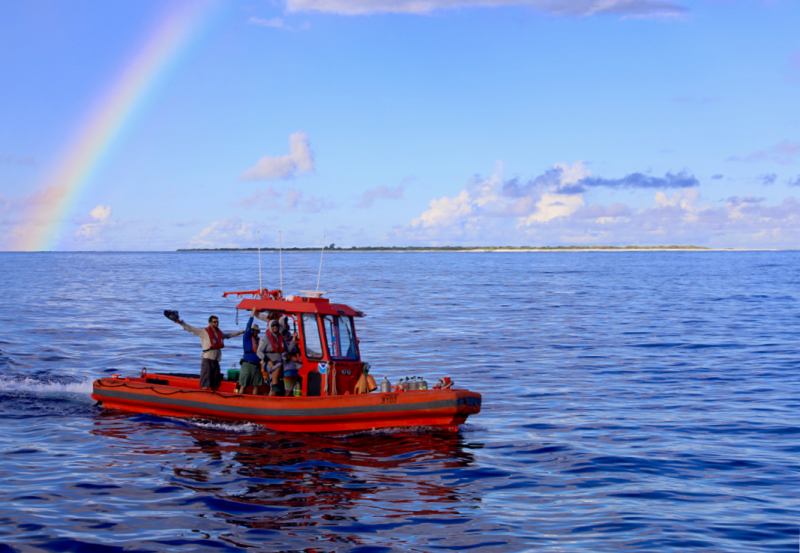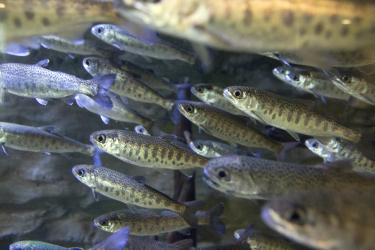Each Earth Day, we pause to appreciate all that our planet gives us. We also think about what we can do to better conserve and restore it. Our oceans, wild places, and the creatures big and small that inhabit our natural world, all elicit wonder and deserve our protection.
After all, “those who contemplate the beauty of the earth find reserves of strength that will endure as long as life lasts,” said writer and conservationist Rachel Carson. “The more clearly we can focus our attention on the wonders and realities of the universe about us, the less taste we shall have for destruction.”
Since the first Earth Day on April 22, 1970, much has changed. Unfortunately, in the decades since, climate change has had an alarming effect on Earth and its inhabitants. At NOAA Fisheries, we work every day to conserve and recover our planet’s marine life and ecosystems and to confront climate change.
Climate Change: The Issue of Our Time
Across the country, we are witnessing real impacts on our marine species and the communities that depend on them due to a rapidly changing climate. From shifting and expanding fish distribution to putting endangered species at even greater risk, there is much at stake.
Marine heatwaves are just one impact having cascading effects in our ocean. In Alaska’s Bering Sea, unprecedented marine heat waves in 2018 and 2019 contributed to the collapse of the snow crab population to historical lows in 2021. Using survey data and laboratory studies, NOAA Fisheries scientists identified starvation as the most likely cause of the mass mortality event during the eastern Bering Sea marine heatwave. This was due to a combination of increased caloric requirements from increased heat and the lack of available food.
Preparing for Climate Change: Inflation Reduction Act
In 2023, NOAA received historic funding under the Inflation Reduction Act—the largest investment in climate action ever and a significant boost to NOAA Fisheries’ science-based management mission. It has allowed us to prioritize and tackle several critical areas impacted by climate change, including accelerating our response to swiftly changing oceans.
Advanced Technology Leads the Way
With the boost from Inflation Reduction Act funding, we’re investing $145 million in cutting-edge technology, modern data systems, and infrastructure, allowing us to surge ahead with essential data collection and rapid data sharing. From satellites to track whales and really cool unmanned systems that expand our survey coverage over larger, harder-to-reach areas, we’ll not only share data quickly and widely with resource managers, we can be more efficient and effective with our science-based management decisions. We’re already using camera technology surveys and artificial intelligence/machine learning in the field. With the new use of ‘omics, environmental DNA, remote sensing, and other strategic initiatives, we are well on our way. It’s very exciting!
It’s fitting to share a recent example of harnessing the power of advanced technology and citizen science during April’s Citizen Science Month. Using A.I., scientists sorted thousands of whale photographs submitted by researchers and the public over 20 years. This data helped them find that recovering humpback whales in the North Pacific are responding to shifts in food availability affected by climate change. It’s amazing to see how technology is furthering our knowledge of whale populations today, and helping track future changes as well.
Tackling Marine Debris
Earth Day 2024’s theme is Planet vs. Plastics. The focus is on working to eliminate plastic usage "for the sake of human and planetary health" and to decrease plastic production by 60 percent by 2040. Today, marine debris and microplastics are a growing concern, negatively affecting coastal communities, marine ecosystems, human health, and the economy. Our oceans are filled with items that do not belong there. Almost every waterway and shoreline is impacted by marine debris, even in areas as remote as the protected Northwestern Hawaiian Islands. Learn how our team surveys and cleans up derelict fishing nets and ocean plastics from the reef and shoreline habitats of the Northwestern Hawaiian Islands.
Marine debris such as consumer plastics and derelict fishing gear can harm marine animals when they get entangled in or ingest them. Because they easily float away on winds and currents, balloons can be a particularly pervasive form of marine debris.
Our Earth, Our Ocean, Our Mission
At NOAA Fisheries, we continue working with our many partners to respond to climate change, adapt to impacts, and do our part to tackle marine debris. We all need to be better stewards of the Earth and take care of our home planet. We do so to make it a better place—for people, for ocean wildlife, and for a more sustainable future.
This year, I’m spending Earth Week on the West Coast reviewing progress on dam removal and restoration along the Klamath River Basin. The restoration of the Klamath watershed, spanning 15,000 miles of California and Oregon, is the largest dam removal project in history! Restoration of this scale takes a "village" and it could not be done without the help of tribes, states, and other amazing partners.
When completed, the dam removal will reopen access to more than 400 miles of habitat for threatened coho salmon, Chinook salmon, steelhead trout, and other threatened native fish. It is the end result of decades of effort by citizens and government entities alike, and perhaps most consequentially, by the tribal nations who first inhabited the area and who relied on the Klamath River for salmon.
I can’t wait to see the restoration already underway! Visit our website to find out more about this incredible and enormous endeavor and our work with many partners to restore the Klamath River Basin.
Happy Earth Day!
Janet Coit,
Assistant Administrator, NOAA Fisheries







